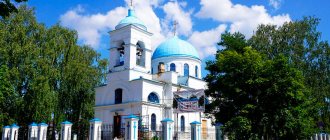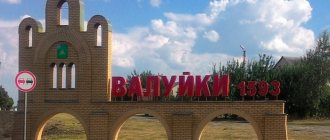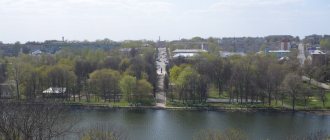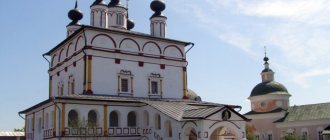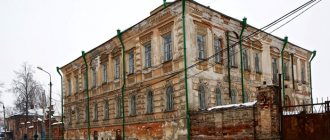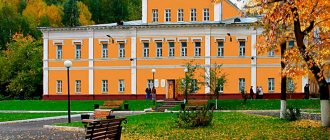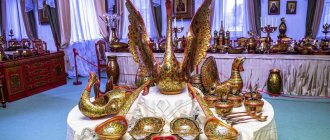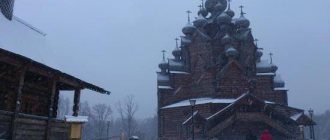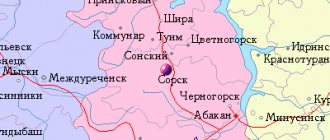Recently, for various reasons, the interest of Russians in domestic tourism has been growing. One of the most popular destinations is small towns located in the European part of the country. Novy Oskol, located 110 km east of Belgorod, belongs to this large group of objects that travelers interested in the Russian province enjoy visiting.
What is interesting about Novy Oskol?
In 1637, a permanent fort was founded on the left bank of the Oskol River. Since 1647, the settlement, which served to protect the roads leading to Moscow from the attacks of the Crimean Tatars, began to be called Tsarev-Alekseev. Later, in 1655, the future city was renamed Novy Oskol. Gradually this place lost its important fortification significance. In the 18th–19th centuries the city developed as a center for bread production. Now Novy Oskol and its surroundings attract tourists with several features:
- protected areas, rich springs, forests and groves;
- ancient sacred buildings;
- recreation opportunities among the natural landscapes of Central Russia;
- monuments telling about different stages of the history of the city and region, starting from the era of the fight against the Crimean Tatars and ending with events related to the liberation of Belgorod land from the Nazi invaders.
In 2021, in Novy Oskol, located 720.5 km south of Moscow, there are 5 large industrial enterprises, 4 secondary schools, Oskol - a center for cultural development - and an agricultural college. There are 13 sculptural compositions and historical monuments erected in the city.
Economy
| : Incorrect or missing image | This section is missing references to information sources. Information must be verifiable, otherwise it may be questioned and deleted. You may edit this article to include links to authoritative sources. This mark is set April 27, 2021 . |
K:Wikipedia:Articles without sources (type: not specified)
- Poultry farm "Prioskolye".
- Furniture factory.
- Bread factory.
- Electrode plant.
- Compound feed plant.
- sale of agricultural machinery "Don".
mass media
Internet
- "Domolink"
- Rostelecom
Press
- Since 1921, the regional newspaper “Forward” has been published.
TV broadcasting
- First channel
- Russia 1 / GTRK Belgorod
- NTV
- World of Belogorye
- Teleradio
- Terrestrial digital TV (package of 10 channels
Broadcasting
- Radio Russia / GTRK Belgorod (Silent) - 73.43 VHF
- Radio Russia / State Television and Radio Broadcasting Company Belgorod (PLAN) - 90.1 MHz
- Road Radio - 91.1 MHz
- TNT MUSIC RADIO - 101.2 MHz
- Radio Mira Belogorya - 102.0 MHz
- Radio 7 on Seven Hills - 105.2 MHz
Culture
Historical Buildings
- House of Culture "Oskol".
- The building of the Novooskolsky District House of Culture, a historical monument.
- Education Department building. historical monument.
- The building of the local history department of the central library.
- Printing house building.
- School building No. 1, girls' gymnasium.
Monuments
- A monument to the founder of the city - Russian Tsar A. M. Romanov (previously there was a monument to V. I. Lenin on this site).
- Memorial of military glory.
- Sculptural bust of Major General A. S. Kostitsin.
- Monument to the soldiers of the 69th Army who liberated Novy Oskol.
- Walk of Fame of Heroes.
- Monument to “Warriors who stood before the world and the Fatherland.”
- The Memorial “Border Guards of All Generations” is the first monument in the city’s Military Glory Park (opened in May 2021[27]).
- Sculptural composition “Family”[28].
- Monument to Princess Olga Romanova[29].
- Monument to Ivan Putilin (opened in June 2021[30]).
- Chernobyl Bell (opened December 2021).
- Monument to front-line soldiers (opened in January 2021).
- Monument to Airborne Paratroopers (opened in August 2021).
Population
| ↘1343 | ↘1000 | ↗2400 | ↗3000 | ↗5200 | ↘2116 | ↘2100 | ↗9100 | ↘5400 | ↗12 908 | |
| 1970[9] | 1979[10] | 1989[11] | 1992[6] | 1996[6] | 1998[6] | 2000[6] | 2001[6] | 2002[12] | 2003[6] | 2005[6] |
| ↗15 850 | ↗17 887 | ↗20 072 | ↗20 100 | ↗20 700 | ↘20 600 | ↗20 800 | →20 800 | ↘20 423 | ↗20 900 | ↘20 600 |
| 2006[6] | 2007[13] | 2008[14] | 2009[15] | 2010[16] | 2011[6] | 2012[17] | 2013[18] | 2014[19] | 2015[20] | 2016[21] |
| ↘20 500 | ↘20 300 | ↘20 200 | ↘20 126 | ↘19 530 | ↘19 500 | ↘19 159 | ↘19 024 | ↘18 911 | ↗18 930 | ↗18 932 |
| 2017[22] | 2018[23] | 2019[24] | 2020[1] | |||||||
| ↘18 856 | ↘18 763 | ↘18 538 | ↘18 478 |
As of January 1, 2021, in terms of population, the city was in 696th place out of 1,116[25]cities of the Russian Federation[26].
Transport
Bus
There is 1 bus station in the city: 10 intercity routes Belgorod, Biryuch, Kharkov, Voronezh, Stary Oskol, Alekseevka, Rovenki, Gubkin, Rossosh and Valuiki. 7 suburban routes Skrynnikovo, Ostapovka, Sharapovka, Trostenets, Borovoe, Novaya Bezginka, Lvovka.
Railway
There is also a railway station: with a total of 7 routes Stary Oskol, Valuyki, Moscow, Belgorod, Sukhum, Rossosh, and Rostov-on-Don.
Taxi
There are more than 5 taxi companies operating in the city with cars of various brands.
Notes
- ↑ 123
Population of the Russian Federation by municipalities as of January 1, 2021 (Russian). Date accessed: October 17, 2021. Archived October 17, 2021. - ↑ 12
THE USSR. Administrative-territorial division of the union republics on January 1, 1980 / Comp. V. A. Dudarev, N. A. Evseeva. - M.: Izvestia, 1980. - 702 p. — P. 101. - ↑ 12
Directory "Liberation of Cities: A Guide to the Liberation of Cities during the Great Patriotic War of 1941-1945." M. L. Dudarenko, Yu. G. Perechnev, V. T. Eliseev and others. M.: Voenizdat, 1985. 598 p. - Red Army website. https://rkka.ru Archived copy from September 30, 2021 on the Wayback Machine.
- Static tables of the Russian Empire
- ↑ 1 2 3 4 5 6 7 8 9 10 11 12 13
People's encyclopedia “My City”.
Novy Oskol (undefined)
. Retrieved November 5, 2013. Archived November 5, 2013. - Kursk provincial statistical department. Population of the cities of Kursk province according to the censuses of 1920 and 1923. [Vol. 3]. - Kursk, 1927.
- All-Union Population Census of 1959. The size of the urban population of the RSFSR, its territorial units, urban settlements and urban areas by gender (Russian). Demoscope Weekly. Access date: September 25, 2013. Archived April 28, 2013.
- All-Union Population Census of 1970 The size of the urban population of the RSFSR, its territorial units, urban settlements and urban areas by gender. (Russian). Demoscope Weekly. Access date: September 25, 2013. Archived April 28, 2013.
- All-Union Population Census of 1979 The size of the urban population of the RSFSR, its territorial units, urban settlements and urban areas by gender. (Russian). Demoscope Weekly. Access date: September 25, 2013. Archived April 28, 2013.
- All-Union population census of 1989. Urban population (undefined)
. Archived from the original on August 22, 2011. - All-Russian Population Census 2002
- Cities of the Belgorod region (number of inhabitants - estimate as of January 1, 2007, thousand people) (unspecified)
. Retrieved May 26, 2021. Archived May 26, 2016. - Cities of the Belgorod region (number of inhabitants - estimate as of January 1, 2008, thousand people) (unspecified)
. Retrieved May 22, 2021. Archived May 22, 2016. - The size of the permanent population of the Russian Federation by cities, urban-type settlements and regions as of January 1, 2009 (unspecified)
. Retrieved January 2, 2014. Archived January 2, 2014. - All-Russian population census 2010. Belgorod region. 15. Population of urban and rural settlements (undefined)
(inaccessible link). Access date: August 15, 2013. Archived August 15, 2013. - Population of the Russian Federation by municipalities. Table 35. Estimated resident population as of January 1, 2012 (unspecified)
. Retrieved May 31, 2014. Archived May 31, 2014. - Population of the Russian Federation by municipalities as of January 1, 2013. - M.: Federal State Statistics Service Rosstat, 2013. - 528 p. (Table 33. Population of urban districts, municipal districts, urban and rural settlements, urban settlements, rural settlements) (undefined)
. Retrieved November 16, 2013. Archived November 16, 2013. - Table 33. Population of the Russian Federation by municipalities as of January 1, 2014 (unspecified)
. Access date: August 2, 2014. Archived August 2, 2014. - Population of the Russian Federation by municipalities as of January 1, 2015 (unspecified)
. Access date: August 6, 2015. Archived August 6, 2015. - Population of the Russian Federation by municipalities as of January 1, 2021 (Russian) (October 5, 2018). Date accessed: May 15, 2021. Archived May 8, 2021.
- Population of the Russian Federation by municipalities as of January 1, 2021 (Russian) (July 31, 2017). Retrieved July 31, 2021. Archived July 31, 2021.
- Population of the Russian Federation by municipalities as of January 1, 2021 (Russian). Retrieved July 25, 2018. Archived July 26, 2021.
- Population of the Russian Federation by municipalities as of January 1, 2021 (Russian). Date accessed: July 31, 2019. Archived May 2, 2021.
- taking into account the cities of Crimea
- https://rosstat.gov.ru/storage/mediabank/bul_Chislen_nasel_MO-01-01-2021.rar Population of the Russian Federation by municipalities as of January 1, 2021 (1.85 Mb, 07/30/2021)
- To
Border Guards of All Generations” was opened in Novy Oskol . Official website of local government bodies of the Novooskol city district (05.28.2018). - The sculptural composition “Family” was opened in Novy Oskol | Novooskol city district (undefined)
. oskoladmin.ru. Access date: June 15, 2021. - A monument to Princess Olga Romanova appeared in Novy Oskol | IA Bel.Ru (Russian). bel.ru. Access date: June 15, 2021.
- A monument to a native of the city, the famous detective Ivan Dmitrievich Putilin was unveiled in Novy Oskol | Novooskol city district (undefined)
. oskoladmin.ru. Access date: June 15, 2021.
Where does the Oskol River flow?
The depth of the reservoir is also quite decent: in some places it reaches about 10 meters. Oskol captured three huge regions: two of them are located on the territory of Russia (these are the Kursk and Belgorod regions), and one is located on the borders of the neighboring state of Ukraine (Kharkov).
The river area is measured at more than 14,500 square meters. km. The river has a current, but it is not strong. Since the reservoir is located primarily in central Russia, it is subject to periods of freezing. From mid-December to March, there is quite strong ice here, the thickness of which reaches 50 cm. The coordinates of the source of the reservoir: 51°36′00″ north latitude and 37°13′00″ east longitude. By the way, Oskol originates in the Kursk region of our country in the Timsky district. The mouth of the Oskol River is in the Kharkov region.
Length, width, depth
As mentioned above, the body of water in question extends over a fairly decent distance - 500 km. Its banks along its entire length are distinguished by their steepness or flatness, and their width varies from 10 to 50 meters. The widest part of the reservoir reaches 300 meters and is located mainly in the Belgorod region, where, in fact, it flows.
The bottom of Oskol is completely sandy, and along the edge of the banks you can see vast areas overgrown with mud. This is due to the fact that the river’s floodplain is almost completely swampy. By the way, this state of affairs did not in any way affect Oskol’s wealth in the fishing industry. Here during the season you can meet a huge number of lovers of a quiet holiday on a boat with a fishing rod.
An excerpt characterizing Novy Oskol
- What? What did he say? - was heard in the ranks of the Polish lancers when one adjutant galloped up to them. It was ordered to find a ford and cross to the other side. The Polish Lancer colonel, a handsome old man, flushed and confused in his words with excitement, asked the adjutant if he would be allowed to swim across the river with his Lancers without looking for a ford. He, with obvious fear of refusal, like a boy who asks permission to mount a horse, asked to be allowed to swim across the river in the eyes of the emperor. The adjutant said that the emperor would probably not be dissatisfied with this excessive zeal. As soon as the adjutant said this, an old mustachioed officer with a happy face and sparkling eyes, raising his saber, shouted: “Vivat! - and, commanding the lancers to follow him, he gave spurs to his horse and galloped up to the river. He angrily pushed the horse that had hesitated beneath him and fell into the water, heading deeper into the rapids of the current. Hundreds of lancers galloped after him. It was cold and terrible in the middle and at the rapids of the current. The lancers clung to each other, fell off their horses, some horses drowned, people drowned too, the rest tried to swim, some on the saddle, some holding the mane. They tried to swim forward to the other side and, despite the fact that there was a crossing half a mile away, they were proud that they were swimming and drowning in this river under the gaze of a man sitting on a log and not even looking at what they were doing. When the returning adjutant, having chosen a convenient moment, allowed himself to draw the emperor’s attention to the devotion of the Poles to his person, a small man in a gray frock coat stood up and, calling Berthier to him, began to walk with him back and forth along the shore, giving him orders and occasionally looking displeasedly at the drowning lancers who entertained his attention. It was not new for him to believe that his presence at all ends of the world, from Africa to the steppes of Muscovy, equally amazes and plunges people into the madness of self-forgetfulness. He ordered a horse to be brought to him and rode to his camp. About forty lancers drowned in the river, despite the boats sent to help. Most washed back to this shore. The colonel and several people swam across the river and with difficulty climbed out to the other bank. But as soon as they got out with their wet dress flopping around them and dripping in streams, they shouted: “Vivat!”, looking enthusiastically at the place where Napoleon stood, but where he was no longer there, and at that moment they considered themselves happy. In the evening, Napoleon, between two orders - one about delivering the prepared counterfeit Russian banknotes for import into Russia as soon as possible, and the other about shooting the Saxon, in whose intercepted letter information about orders for the French army was found - made a third order - about the inclusion of the Polish colonel, who unnecessarily threw himself into the river, into the cohort of honor (Legion d'honneur), of which Napoleon was the head. Qnos vult perdere – dementat. [Whoever he wants to destroy, he will deprive him of his reason (lat.)] Meanwhile, the Russian emperor had already lived in Vilna for more than a month, making reviews and maneuvers. Nothing was ready for the war that everyone expected and for which the emperor came from St. Petersburg to prepare. There was no general plan of action. Hesitation about which plan, out of all those that were proposed, should be adopted, only intensified even more after the emperor's month-long stay in the main apartment. The three armies each had a separate commander-in-chief, but there was no common commander over all the armies, and the emperor did not assume this title. The longer the emperor lived in Vilna, the less and less they prepared for war, tired of waiting for it. All the aspirations of the people surrounding the sovereign seemed to be aimed only at making the sovereign, while having a pleasant time, forget about the upcoming war. After many balls and holidays among the Polish magnates, among the courtiers and the sovereign himself, in June one of the Polish general adjutants of the sovereign came up with the idea of giving a dinner and ball to the sovereign on behalf of his general adjutants. This idea was joyfully accepted by everyone. The Emperor agreed. The general's adjutants collected money by subscription. The person who could be most pleasing to the sovereign was invited to be the hostess of the ball. Count Bennigsen, a landowner of the Vilna province, offered his country house for this holiday, and on June 13 a dinner, ball, boat ride and fireworks display were scheduled at Zakret, Count Bennigsen's country house. On the very day on which Napoleon gave the order to cross the Neman and his advanced troops, pushing back the Cossacks, crossed the Russian border, Alexander spent the evening at Bennigsen’s dacha - at a ball given by the general’s adjutants. It was a cheerful, brilliant holiday; experts in the business said that rarely so many beauties gathered in one place. Countess Bezukhova, along with other Russian ladies who came for the sovereign from St. Petersburg to Vilna, was at this ball, darkening the sophisticated Polish ladies with her heavy, so-called Russian beauty. She was noticed, and the sovereign honored her with a dance. Boris Drubetskoy, en garcon (a bachelor), as he said, having left his wife in Moscow, was also at this ball and, although not an adjutant general, was a participant for a large sum in the subscription for the ball. Boris was now a rich man, far advanced in honor, no longer seeking patronage, but standing on an even footing with the highest of his peers. At twelve o'clock at night they were still dancing. Helen, who did not have a worthy gentleman, herself offered the mazurka to Boris. They sat in the third pair. Boris, coolly looking at Helen's shiny bare shoulders protruding from her dark gauze and gold dress, talked about old acquaintances and at the same time, unnoticed by himself and others, never for a second stopped watching the sovereign, who was in the same room. The Emperor did not dance; he stood in the doorway and stopped first one or the other with those gentle words that he alone knew how to speak. At the beginning of the mazurka, Boris saw that Adjutant General Balashev, one of the closest persons to the sovereign, approached him and stood un-courtly close to the sovereign, who was speaking with a Polish lady. After talking with the lady, the sovereign looked questioningly and, apparently realizing that Balashev acted this way only because there were important reasons, nodded slightly to the lady and turned to Balashev. As soon as Balashev began to speak, surprise was expressed on the sovereign’s face. He took Balashev by the arm and walked with him through the hall, unconsciously clearing three fathoms of wide road on both sides of those who stood aside in front of him. Boris noticed Arakcheev's excited face while the sovereign walked with Balashev. Arakcheev, looking from under his brows at the sovereign and snoring his red nose, moved out of the crowd, as if expecting that the sovereign would turn to him. (Boris realized that Arakcheev was jealous of Balashev and was dissatisfied that some obviously important news was not conveyed to the sovereign through him.) But the sovereign and Balashev walked, without noticing Arakcheev, through the exit door into the illuminated garden. Arakcheev, holding his sword and looking around angrily, walked about twenty paces behind them. While Boris continued to make mazurka figures, he was constantly tormented by the thought of what news Balashev had brought and how to find out about it before others. In the figure where he had to choose ladies, whispering to Helen that he wanted to take Countess Pototskaya, who seemed to have gone out onto the balcony, he, sliding his feet along the parquet floor, ran out the exit door into the garden and, noticing the sovereign entering the terrace with Balashev , paused. The Emperor and Balashev headed towards the door. Boris, in a hurry, as if not having time to move away, respectfully pressed himself against the lintel and bowed his head.
The mystery of the name and the attitude of Peter the Great to the Oskol River
The last Russian Tsar and our first Emperor Peter Alekseevich during his reign transported ships through Oskol. In the absence of railways, provisions and other goods of general demand and consumption were delivered via the same reservoir. Since the river stretches over a vast territory, capturing quite a lot of areas and regions on its way, it, without a doubt, came to the attention of the far-sighted Russian Emperor. By the way, Oskol is a tributary of the Seversky Donets, which, in turn, as is known, is a right tributary of the Don, and this opens up even more routes of communication with vast territories of the country.
There are several beliefs regarding the mystery of the name of the river:
- It was believed that the reservoir exposed white chalk deposits of its steep banks, which were popularly called skolki. From this word came the current name of the river, familiar to everyone.
- The ancient peoples inhabiting the banks of the reservoir were called wasps, and in Turkic “kol” is a river. It turns out that Oskol is nothing more than a river of wasps.
In conclusion, I would like to note the need to protect our native spaces and take care of the cleanliness of water bodies, because humans are the main threat to the environment.
